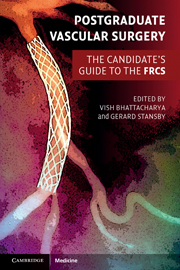Book contents
- Frontmatter
- Contents
- List of contributors
- Preface
- Section 1 Final FRCS vascular clinicals
- Section 2 Final FRCS vascular topics
- 1 Vascular risk factors and their management
- 2 Management of acute limb ischaemia
- 3 Chronic lower limb ischaemia, critical ischaemia and the diabetic foot
- 4 Endovascular and surgical options for peripheral revascularisation
- 5 Abdominal aortic aneurysms
- 6 Thoracic, thoracoabdominal and suprarenal aortic aneurysms
- 7 Aortic dissection
- 8 Popliteal artery aneurysms
- 9 Femoral artery aneurysms
- 10 Carotid, subclavian and vertebral disease
- 11 Diagnosis and management of thoracic outlet syndrome
- 12 Diagnosis and management of hyperhidrosis
- 13 Chronic mesenteric ischaemia
- 14 Acute ischaemic colitis
- 15 Vascular trauma
- 16 Indications and management of lower limb amputation
- 17 Leg swelling and lymphoedema
- 18 Varicose veins and chronic venous insufficiency
- 19 Management of deep vein thrombosis
- 20 Infection in vascular surgery
- 21 Vascular malformations
- 22 Vasospastic disorders and vasculitis
- 23 Critical care considerations and preoperative assessment for general and vascular surgery
- 24 Access surgery
- 25 Basic outline of solid organ transplantation
- Index
- References
22 - Vasospastic disorders and vasculitis
- Frontmatter
- Contents
- List of contributors
- Preface
- Section 1 Final FRCS vascular clinicals
- Section 2 Final FRCS vascular topics
- 1 Vascular risk factors and their management
- 2 Management of acute limb ischaemia
- 3 Chronic lower limb ischaemia, critical ischaemia and the diabetic foot
- 4 Endovascular and surgical options for peripheral revascularisation
- 5 Abdominal aortic aneurysms
- 6 Thoracic, thoracoabdominal and suprarenal aortic aneurysms
- 7 Aortic dissection
- 8 Popliteal artery aneurysms
- 9 Femoral artery aneurysms
- 10 Carotid, subclavian and vertebral disease
- 11 Diagnosis and management of thoracic outlet syndrome
- 12 Diagnosis and management of hyperhidrosis
- 13 Chronic mesenteric ischaemia
- 14 Acute ischaemic colitis
- 15 Vascular trauma
- 16 Indications and management of lower limb amputation
- 17 Leg swelling and lymphoedema
- 18 Varicose veins and chronic venous insufficiency
- 19 Management of deep vein thrombosis
- 20 Infection in vascular surgery
- 21 Vascular malformations
- 22 Vasospastic disorders and vasculitis
- 23 Critical care considerations and preoperative assessment for general and vascular surgery
- 24 Access surgery
- 25 Basic outline of solid organ transplantation
- Index
- References
Summary
Key points
Understanding of the nomenclature used for the classification of vasospastic disorders into primary and secondary Raynaud's phenomena is essential
The management of these disorders requires a multidisciplinary team approach involving physicians, rheumatologists and vascular specialists
Treatment of Raynaud's includes general supportive measures, pharmacotherapy and correction of underlying disorders
Vasculitis is associated with a range of medical conditions and can present as digital ischaemia
A diagnosis of vasculitis is suggested by constitutional symptoms and confirmed by raised inflammatory markers, autoantibodies and biopsy of the skin lesions
Immunosuppressive therapy is the mainstay of treatment in vasculitic disorders
Introduction
Raynaud's phenomenon refers to a clinical state characterised by episodic vasospasm, usually involving the distal small arteries of the upper limb although sometimes toes and feet are also affected. In addition, there are other vascular disorders characterized by inflammatory changes in the arterial wall, known as ‘vasculitidies’, which can present with digital ischaemia.
Vasospasm (Raynaud's phenomenon)
Maurice Raynaud first described this clinical picture in 1862. The classical presentation of Raynaud's phenomenon is characterised by a sequence of colour changes in the following order:
pallor, reflecting initial vasospasm;
cyanosis as a result of deoxygenation of stagnant blood during maximum vasospasm;
rubor, representing inflow of oxygenated blood and reactive hyperaemia as the vasospasm subsides.
Episodes usually last for 30–60 min. However, some patients present with only cold hands and do not exhibit the classical triple colour response although they demonstrate a similar blood flow pattern to classical vasospasm.
- Type
- Chapter
- Information
- Postgraduate Vascular SurgeryThe Candidate's Guide to the FRCS, pp. 254 - 271Publisher: Cambridge University PressPrint publication year: 2011



